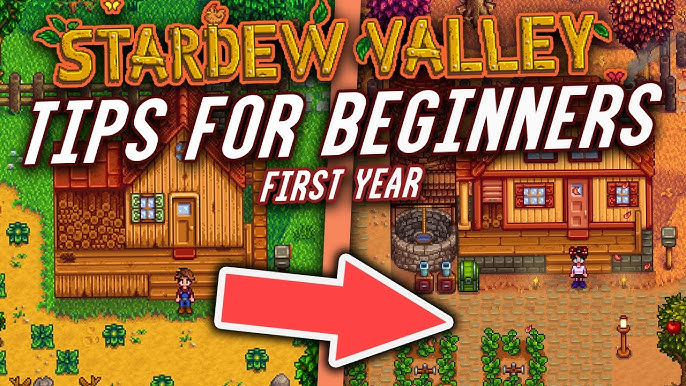Essential Stardew Valley Tips for New and Experienced Players

Introduction to Stardew Valley
Stardew Valley Tips is a farming simulation game that has captured the hearts of players worldwide. Developed by ConcernedApe, the game invites players to step into the shoes of a character who inherits their grandfather’s neglected farm in the quaint town of Pelican Town. This immersive title provides users with a unique opportunity to cultivate their land, raise a variety of animals, and participate in the vibrant local community. Players can engage in various activities including mining, fishing, and foraging, thus creating a rich and diversified gameplay experience.
One of the key reasons Stardew Valley has gained immense popularity is its balance of relaxation and gameplay depth. Casual gamers appreciate the serene environment and the freedom to progress at their own pace, while more dedicated players enjoy mastering the intricate systems of farming, crafting, and relationship-building. The captivating pixel art style, along with an enchanting soundtrack, enhances the experience, drawing players into the charming and immersive world of Stardew Valley.
As players embark on their agricultural journey, having a wealth of knowledge can significantly enhance their experience. This is where essential Stardew Valley tips come into play, ensuring that both new and seasoned players can maximize their productivity and enjoyment. Whether it’s understanding the intricacies of crop rotations, harnessing the power of community support, or effectively managing one’s time, these tips can serve as valuable resources. By implementing effective strategies, players can enjoy a more fulfilling gaming experience, making the most out of their time in this delightful pixelated paradise.
Getting Started: The First Days
The initial days in Stardew Valley are crucial for establishing the foundation of your farming career. To make the most of this time, it is advisable to focus on planting crops that yield quick returns. Early in the game, you have limited resources, so selecting crops such as parsnips or potatoes can be beneficial; these options not only grow rapidly but also help generate the income needed to expand your farm. Make sure to use your initial funds wisely to purchase seeds from Pierre’s General Store, as this will set the pace of your growth.
Managing your resources effectively is another essential factor during the first days. Your energy levels are limited, especially in the beginning, so prioritize your tasks. A good strategy is to alternate between farming, foraging, and mining. Begin with simple activities, such as watering your crops or clearing stones and branches from your farm, to ensure you do not exhaust your energy too quickly. This balanced approach will allow you to maximize productivity while preserving your stamina.
Additionally, exploring the town and interacting with the villagers is vital for creating a thriving ecosystem within the game. Each villager has unique likes and dislikes, and forging positive relationships with them can result in gifts or valuable items. During your exploration, be sure to check out local shops aside from Pierre’s, as they often sell useful items that can aid your farming journey. The Adventurer’s Guild, for instance, provides materials important for crafting tools later in the game, emphasizing the importance of mining.
Familiarizing yourself with these various aspects during your initial days will significantly enhance your gaming experience. Optimizing your actions through efficient resource management and community interactions firmly lays the groundwork for sustainable growth in Stardew Valley.
Efficient Farming Techniques
Maximizing crop yields in Stardew Valley requires an understanding of several farming techniques that can significantly enhance productivity. One of the first considerations for any farmer is the seasonal aspect of crops. Each crop can only be grown in specific seasons, so knowing which crops are available during spring, summer, and fall is crucial. For example, strawberries, which can yield high profits, are available only in spring. Planting crops during their appropriate seasons ensures maximum growth and harvest efficiency.
In addition to seasonality, the utilization of fertilizers can greatly impact crop quality and yield. Fertilizers serve various purposes—from increasing growth rates to enhancing the quality of harvested produce. Beginners might consider basic fertilizers that require simple crafting materials, such as mixed seeds. However, advanced players should aim for higher-tier fertilizers that can significantly improve crop outcomes. Additionally, using quality fertilizer on high-value crops increases profits, making it well worth the effort.
Another aspect to consider is the optimal layout of farm plots. Efficient organization of your farm can drastically reduce wasted space and increase productivity. Employing a grid design allows for easy navigation while ensuring that every square foot contributes to your farming efforts. Moreover, grouping crops that require similar care can save time. This concept extends to implementing crop rotation and diversification. By rotating different crop types each season, players can prevent soil depletion and maintain a productive farm throughout the year.
Lastly, diversifying crop choices is a fundamental strategy that allows players to adapt to market fluctuations. Growing a variety of crops can mitigate risks associated with poor sales in a specific crop. In summary, these efficient farming techniques collectively offer a roadmap for both new and experienced Stardew Valley players to optimize their farming ventures and achieve greater success within the game.
Time Management in Stardew Valley
Managing time effectively in Stardew Valley is crucial for maximizing productivity and enjoyment within the game. Each day in Stardew Valley is limited to 28 in-game hours, making it essential for players to plan their activities carefully. This planning allows players to accomplish vital tasks such as farming, mining, or fishing, ensuring they make the most of their limited time. One key tip for managing time effectively is to establish a daily routine. By determining which activities are the highest priority for each day, players can streamline their progress and enjoy a more balanced game experience.
Additionally, it is essential to consider the seasons and their associated crops and festivals while planning each day. Certain crops are only available during specific seasons, and neglecting to plant them at the appropriate time can result in a lost opportunity for profit. Moreover, seasonal festivals can present unique challenges and rewards, so players should schedule their day around these events to reap maximum benefits. By prioritizing in-game activities based on urgency and importance, players can optimize their time management, ensuring that essential tasks are completed efficiently.
Another helpful aspect of time management in Stardew Valley is the use of in-game tools. Players can leverage items such as the calendar found in Pierre’s General Store, which helps in tracking upcoming birthdays and events, to plan their time effectively. Additionally, utilizing the Map feature allows players to see the locations of various activities, facilitating better planning. Taking some time to familiarize oneself with these tools can significantly enhance a player’s overall time management skills and contribute to a successful experience in farmland management.
Fishing and Foraging: Gathering Resources
In Stardew Valley, fishing and foraging are essential activities that can significantly boost your farm’s economy while providing various resources. Understanding the mechanics of both activities can help you excel in gathering valuable items and increasing your earnings.
Fishing is a multifaceted endeavor in the game, with different fish available depending on the season, time of day, and location. To maximize your catch, players should invest in a good fishing rod early in their journey. The basic fishing rod is sufficient, but upgrading to better rods allows access to various bait types and tackle that can improve catch rates. Each season introduces new fish, making it crucial to be aware of what is available at different times. For example, during Spring, players can catch fish like the Catfish or the Salmon, whereas during Winter, it’s a good idea to look for the Ice Pip. Keeping a fishing journal or utilizing online resources to track which fish can be caught when will prove beneficial.
Foraging complements fishing by allowing players to gather wild resources scattered throughout the valley. Certain items, such as wild berries, mushrooms, and seasonal flowers, can greatly enhance your food supply or be used in crafting. Optimal foraging spots include the forest areas, beach, and mountains, each offering distinct items depending on the season. Seasonal foraging not only provides sustenance but also presents opportunities for crafting artisan goods, which can result in higher profits. Additionally, foraging contributes to completing bundles in the Community Center, leading to rewards that can benefit your farm overall.
In summary, mastering these stardew valley tips on fishing and foraging enhances your gameplay experience. Developing a strategy for when and where to gather fish and wild items significantly supports your farm’s economy and sets you on the path to success in Stardew Valley.
Interacting with Villagers: Building Relationships
In Stardew Valley, building relationships with villagers is an essential aspect that can significantly enhance your gameplay experience. By fostering friendships with the various in-game characters, players can gain valuable insights, receive unique recipes, and unlock crafting items that are pivotal for progression. Effective communication is the foundation of these relationships, and it begins with engaging in conversations regularly. Make it a point to talk to different villagers daily, as each character has their own distinct dialogue that reveals their personalities and preferences.
Gifting is another crucial element in building these connections. Each villager has specific items they favor, which can be found out through dialogue or by observing their reactions. Presenting gifts that align with their preferences yields friendship points. While planning your gifts, it is wise to be mindful of the villagers’ birthdays, as gifts given on these days provide extra points, making them a prime opportunity to strengthen bonds. Aim for a variety of gifts to keep the interactions fresh—try including handmade items or foraged goods.
Participation in community events is equally important. Stardew Valley hosts various seasonal festivals where villagers gather to celebrate and socialize. Engaging in these events not only allows for further interaction but also helps to entrench your standing in the community. By attending these celebrations, you demonstrate your commitment to the town and its inhabitants. Over time, as you build friendships, the rewards become apparent. Increased friendship levels can lead to special heart events, unique rewards such as recipes for dishes and crafting blueprints, and even opportunities for romantic relationships, which can be rewarding both emotionally and in gameplay. Overall, focusing on these relationship-building stardew valley tips will enrich your experience within the game and offer many long-term benefits.
Mining: Strategies for Success
Mining is a crucial aspect of Stardew Valley, offering players valuable resources that can enhance their gameplay. To successfully explore the mines, players should employ effective strategies that can make their endeavors more efficient and rewarding. First and foremost, it is essential to prepare adequately before embarking on a mining expedition. Ensure you bring a sufficient supply of food to restore health and energy, as these two resources are crucial when dealing with dangerous creatures in the mines.
Tool upgrades play a significant role in successful mining. Investing in better tools allows players to mine through rocks more quickly and reduces energy expenditure. Start by upgrading your pickaxe to at least copper or iron level, as this will enable you to gather valuable ores like iron and gold more efficiently. Remember that some ores and gems are rarer than others, so focus on mining specific layers where certain resources are more abundant. For example, players can find copper ore in the earlier levels of the mines, while deeper levels contain iron ore and potentially rare gems like diamonds and emeralds.
Prioritizing which ores and gems to gather can maximize profits. For crafting and selling, prioritize obtaining gold ores, as they can fetch a higher price. Gems also have a high resale value, so it is beneficial to invest time in collecting them whenever possible. Additionally, be on the lookout for mining treasures, such as geodes and artifacts, which can significantly boost your resources. While mining can be a rewarding experience, it is essential to maintain your character’s health and safety. Stay vigilant for enemy attacks, and consider navigating back to the surface should your health become critically low.
In conclusion, employing effective strategies for mining in Stardew Valley can enhance both productivity and overall enjoyment. Focus on upgrading tools, prioritizing important ores and gems, and ensuring your safety during expeditions to make the most out of your mining experience.
Crafting and Upgrading Tools
The crafting system in Stardew Valley is a crucial aspect that allows players to enhance their farming experience. Crafting enables players to create a wide range of items, from basic tools to advanced farm equipment, contributing significantly to farm efficiency. Understanding the crafting recipes is essential, as it not only expands the capabilities of your farm but also diversifies your gameplay. When beginning your journey, players should prioritize learning how to craft essential tools such as a hoe, axe, and pickaxe, as these will be vital for daily tasks.
Upgrading tools in Stardew Valley is a key strategy that improves their effectiveness, ensuring that players can handle tasks more efficiently. The upgrade process typically involves collecting specific resources, such as metal bars, which can be obtained through mining or smelting. Once you gather the necessary materials, visiting the Blacksmith allows for tool enhancements that increase range and durability. It is advisable to evaluate your play style when deciding on upgrades; for instance, if you prefer farming, prioritize upgrading your watering can and hoe to manage crops more effectively.
In terms of cost-effectiveness, investing in tool upgrades can save time and resources in the long run. Each upgraded tool significantly reduces the energy consumed during tasks while also increasing the overall speed at which the activities are performed. This efficiency translates into greater productivity on the farm, as players can complete more tasks in a shorter period. For players still developing their farming strategy, it is best to observe which tools are most utilized in your gameplay and target those for upgrades first. Crafting and upgrading tools ultimately play a pivotal role in enhancing both the efficiency and enjoyment of your Stardew Valley experience.
Final Tips and Tricks for Stardew Valley Success
As players embark on their journey in Stardew Valley, there are numerous strategies that can greatly enhance their gaming experience. One important aspect to consider is inventory management. Keeping your inventory organized can make a significant difference in your farming efficiency. Use chests to store seasonal crops, resources, and tools that are not currently in use. Labeling storage chests can facilitate easy access to items, allowing you to focus on farming and community tasks without constantly managing a cluttered inventory.
Utilizing the community center is another crucial element to thriving in Stardew Valley. Engage with the various bundles that require different items, which can lead to essential rewards including new buildings and farming possibilities. Prioritize these bundles based on the seasons and your farming output, as completing them not only improves your farm but also brings the community together. Ensuring you contribute items from your farm will not only benefit your gameplay but also enhance your gaming experience.
Participating in seasonal events should not be overlooked. Events such as the Egg Festival, the Pumpkin Festival, and the Night Market provide unique opportunities to earn rewards, build relationships with fellow villagers, and enhance your farming prowess. These events often feature mini-games and competitions that add excitement to the game while allowing players to gather rare items that are not accessible during regular gameplay. As you engage in these festive activities, you will not only improve your farming skills but also deepen your connection to the game’s community.
In conclusion, incorporating these stardew valley tips, such as optimizing inventory management, utilizing the community center effectively, and participating in seasonal events, can lead to a more fulfilling and productive farming adventure. Embrace these strategies, and you will undoubtedly find greater success and enjoyment in your Stardew Valley endeavors.
You May Also Read This Usaworldtoday.



